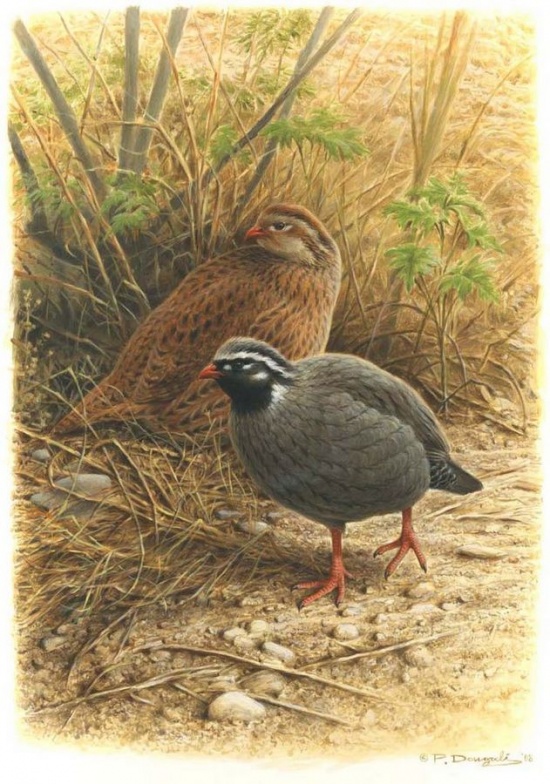m |
(Imp sizes. C/right. User template. All sections now started. References updated. Incomplete gone) |
||
| (One intermediate revision by one other user not shown) | |||
| Line 1: | Line 1: | ||
{{extinct?}} | {{extinct?}} | ||
| − | + | [[Image:Himalayan_Quail_B.jpg|thumb|550px|right|Artwork © by {{user|spizaetos|spizaetos}}]] | |
| − | |||
| − | [[Image:Himalayan_Quail_B.jpg|thumb|550px|right|Artwork by spizaetos]] | ||
;[[:Category:Ophrysia|Ophrysia]] superciliosa | ;[[:Category:Ophrysia|Ophrysia]] superciliosa | ||
==Identification== | ==Identification== | ||
| − | '''Male:''' Slate-grey, tinged with olive above, and with black edgings to the sides of the feathers, a black, head streaked with white, and black under-tail-coverts spotted with white.<br> | + | 25 cm (9¾ in)<br /> |
| − | '''Female:''' Brown, spotted with black centres to the feathers and the face a sort of pinkish grey. The bill is red, bright coral in the male and dusky in the female, and the legs are dull red. | + | '''Male:'''<br /> |
| + | Slate-grey, tinged with olive above, and with black edgings to the sides of the feathers, a black, head streaked with white, and black under-tail-coverts spotted with white.<br /> | ||
| + | '''Female:'''<br /> | ||
| + | Brown, spotted with black centres to the feathers and the face a sort of pinkish grey. The bill is red, bright coral in the male and dusky in the female, and the legs are dull red. | ||
==Distribution== | ==Distribution== | ||
Western [[Himalayas]] in north-western [[India]]. | Western [[Himalayas]] in north-western [[India]]. | ||
| Line 12: | Line 13: | ||
Classified as '''Critically Endangered''' in the 2008 IUCN Red List.<sup>[[#References|1]]</sup> No reliable records since 1876. | Classified as '''Critically Endangered''' in the 2008 IUCN Red List.<sup>[[#References|1]]</sup> No reliable records since 1876. | ||
==Taxonomy== | ==Taxonomy== | ||
| − | + | This is a [[Dictionary_M-S#M|monotypic]] species<sup>[[#References|[1]]]</sup>. | |
==Habitat== | ==Habitat== | ||
Steep slopes with long grass and scrub at altitudes of 1 650 to 2 400 m. | Steep slopes with long grass and scrub at altitudes of 1 650 to 2 400 m. | ||
==Behaviour== | ==Behaviour== | ||
| + | ====Diet==== | ||
| + | Their diet consists of grass seeds. They also probably eat some berries. | ||
| + | ====Breeding==== | ||
| + | There is no information available. | ||
==References== | ==References== | ||
| − | BirdLife International. 2008. Species factsheet: ''Ophrysia superciliosa''. Downloaded from [http://www.birdlife.org/datazone/search/species_search.html?action=SpcHTMDetails.asp&sid=235&m=0 http://www.birdlife.org] on 25/12/2008. | + | #{{Ref-Clements6thAug18}}#BirdLife International. 2008. Species factsheet: ''Ophrysia superciliosa''. Downloaded from [http://www.birdlife.org/datazone/search/species_search.html?action=SpcHTMDetails.asp&sid=235&m=0 http://www.birdlife.org] on 25/12/2008. |
| + | #Handbook of the Birds of the World Alive (retrieved May 2019) | ||
| + | {{ref}} | ||
==External Links== | ==External Links== | ||
{{GSearch|Ophrysia+superciliosa}} | {{GSearch|Ophrysia+superciliosa}} | ||
| − | [[Category:Birds]] [[Category:Ophrysia]] [[Category:Artwork Only]] | + | [[Category:Birds]] [[Category:Ophrysia]] [[Category:Artwork Only]] [[Category: Missing Images]] |
Latest revision as of 23:30, 6 May 2019

|
The species Himalayan Quail is possibly extinct. |

|

- Ophrysia superciliosa
Identification
25 cm (9¾ in)
Male:
Slate-grey, tinged with olive above, and with black edgings to the sides of the feathers, a black, head streaked with white, and black under-tail-coverts spotted with white.
Female:
Brown, spotted with black centres to the feathers and the face a sort of pinkish grey. The bill is red, bright coral in the male and dusky in the female, and the legs are dull red.
Distribution
Western Himalayas in north-western India.
Status
Classified as Critically Endangered in the 2008 IUCN Red List.1 No reliable records since 1876.
Taxonomy
This is a monotypic species[1].
Habitat
Steep slopes with long grass and scrub at altitudes of 1 650 to 2 400 m.
Behaviour
Diet
Their diet consists of grass seeds. They also probably eat some berries.
Breeding
There is no information available.
References
- Clements, J. F., T. S. Schulenberg, M. J. Iliff, D. Roberson, T. A. Fredericks, B. L. Sullivan, and C. L. Wood. 2018. The eBird/Clements checklist of birds of the world: v2018. Downloaded from http://www.birds.cornell.edu/clementschecklist/download/
- BirdLife International. 2008. Species factsheet: Ophrysia superciliosa. Downloaded from http://www.birdlife.org on 25/12/2008.
- Handbook of the Birds of the World Alive (retrieved May 2019)
Recommended Citation
- BirdForum Opus contributors. (2024) Himalayan Quail. In: BirdForum, the forum for wild birds and birding. Retrieved 13 May 2024 from https://www.birdforum.net/opus/Himalayan_Quail



